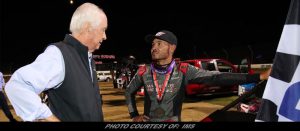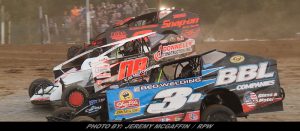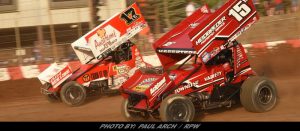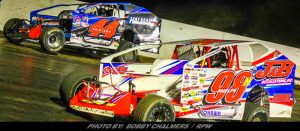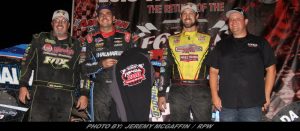Sammons To Receive Dirt Mod Hall Of Fame Media Award
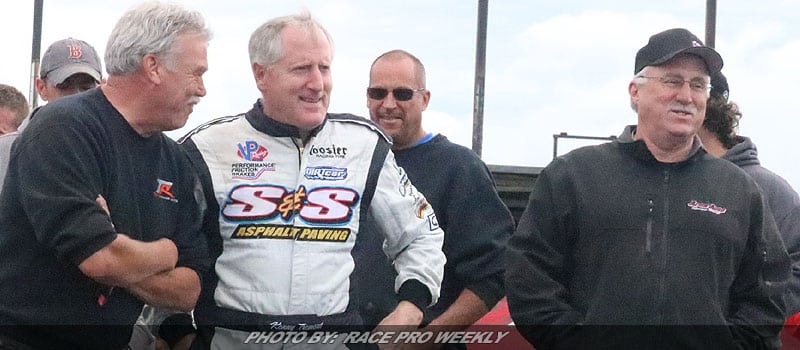
Story By: BUFFY SWANSON / NORTHEAST DIRT MODIFIED HALL OF FAME – WEEDSPORT, NY – What started out as a four-page lithographed rundown of local auto racing has become the last bastion of weekly motorsports print coverage on the market.
The man at the helm, Area Auto Racing News publisher and journalist Lenny H. Sammons, will receive the Andrew S. Fusco Award for Media Excellence at the 2017 Northeast Dirt Modified Hall of Fame induction ceremonies on Monday, July 10, in Weedsport, NY.
Sammons was only seven when his dad, Leonard Jr., decided to put together a little racing recap covering the tracks nearest to their Trenton, NJ, home: Flemington, Nazareth, Old Bridge, Vineland and Wall Stadium. Four pages for a quarter, along with a scorecard featuring local advertising for each track.
That was in 1963. The following year, Area Auto Racing News was a full-time operation, assembling a 12-page publication in a rented office at 2829 South Broad Street, Trenton, where it is still produced today.
A lot has happened in the publishing business in the past 50-odd years, and Sammons was there for all of it.
“My father didn’t have a lot of money and he was sickly at the time, but he was able to get guys like Frankie Schneider, Al Tasnady and others to invest in the paper, become stockholders. He bought them all out as time went on,” Sammons explained.
When Illustrated Speedway News went out of business, AARN was able to pick up award-winning writers and photographers like Walt Chernokal and Ernie Saxton. The staff grew, and so did the paper.
“People were just dying for coverage of local racing because it was no place. There was nothing. That’s why records are so hard to trace prior to 1964,” Lenny recounted. “You’d have to go to your local paper and hope they covered a race — most times, they only listed the top three.”
Leonard Jr. was a savvy businessman, surrounding the central newspaper with promotions of all kinds: Off-season banquets that attracted as many as 1,000 attendees. Most popular driver contests. Speedway novelties. All satellite interests that would sell papers.
“The one thing we didn’t have a lot of in the beginning was cash. By getting in the novelty business, we were able to have a strong income and sell papers at the same time,” Sammons related.
As a teenager, young Lenny shot pictures at the tracks and he and his friends also followed the midweek All-Star Racing League, handling program and T-shirt sales. His father gave him the idea to create fan buttons featuring popular drivers and it took off.
“We had a sweat shop in my basement with kids from the neighborhood, who’d probably never been to a race before, hammering out the circles and putting buttons together. At one time, I had probably 5-10 different race tracks where we sold buttons,” he remembered. “My grandfather took me to a lot of those races because none of us was old enough to drive.”
Sammons made enough “button” money to buy a 1972 Mustang Mach I when he got his driver’s license.
As his father’s health failed when he was a senior in high school, Lenny stepped up to take on more and more responsibility for the newspaper’s production — first as a press assistant, then press operator, then plant manager.
It was quite the operation back in the day, involving out-of-shop zinc engravings for each photo, linotype, poured lead plates. “A plate would weigh 25 pounds or more. 150 degrees in those buildings in the summer. No air conditioning! Working with a four-foot high bowl of lead you’d pour to make the plates,” Sammons detailed.
He began doing page layouts — and, by necessity, he started writing.
AARN editor Pat Singer and columnist Ron Mentus were early mentors. “Ron especially: He told me, ‘Don’t use a notebook, don’t use a tape recorder. Get the guy’s true feelings, then go in a corner and write what he means to say.’ I learned to really listen,” Lenny said.
“I’ve always tried to take myself out of it. My view is totally different than the guy behind the wheel. I never raced,” he continued. “I don’t think people care that much about what I think or what I have to say. So I offer the drivers the opportunity to speak their minds and tell their side of the story.”
When Singer left to work at the Philadelphia Journal in 1977, Sammons assumed her position as editor. He was 22 years old.
And the industry was rapidly evolving, commanding a constant learning curve. The printing process progressed from hot lead to offset and cold type. Printing was done in-house and outsourced. Laborious light table layouts, pasting up photos and long galleys of Compugraphic type, were eventually succeeded by computerized operations and digital design programs. Reporters started to rely on laptops, eliminating the role of typesetters.
Lenny kept abreast of it all. In 1979, AARN was the first trade paper to run a color cover, for its special Syracuse edition. Five years later, the paper was featuring color photos weekly. Currently, Sammons is running 16 pages of color in each issue, with a goal of going full color in the future.
And the future is what it’s all about. Now his two sons, Danny and Davey, work by Lenny’s side — Danny handling all the advertising and bookkeeping, Davey as photo editor and mailing manager. Sammons has laid out every issue of AARN for the past 30 years — but his sons are now pitching in. What they do behind the scenes “allows me to spend more time going to the races,” he acknowledged.
At age 62, Sammons isn’t slowing down anytime soon. He’s on top of the breaking news, from Quarter Midgets to Cup. He’s writing prolifically about what we love, providing perspective and scope you can’t find on Internet blogs. Still slugging out 50 issues a year and making that weekly deadline, while producing special racing events and the most successful trade show in the Northeast.
“Our Motorsports show has been fantastic for us,” Lenny said of the annual trade show he organized in 1984. “That replaced the novelty business.” And offers another opportunity to plug the newspaper as a must-read.
In the meantime, venerable trade publications like National Speed Sport News, Speedway Scene, Gater Racing News, Circle Track and Stock Car Racing magazines have all folded. They are gone, all gone. Lenny Sammons is the last man standing.
Is he worried that print is dead? Sammons has hedged his bets by making an online edition available to all AARN subscribers. But he’s not worried. “We’ve lost our competition — which probably didn’t hurt,” he conceded, “But people still constantly come to us saying they love holding that paper in their hands. There’s something special about that.”
Sammons has hopes of keeping it all in the family, perhaps passing down his dad’s masthead to his grandchildren. “I think that certainly could happen. My two sons are very intelligent people,” Lenny pointed out. “They wouldn’t be working for me if they thought there was no future in it!”


